FRENCH POLICE SWEEP PARIS OF JEWS
Paris, Occupied France · July 16, 1942
On June 22, 1940, representatives of Marshal Philippe Pétain, premier of the French Third Republic, signed a ceasefire with Germany, 44 days after the Wehrmacht (German armed forces) had invaded France. Early in October Pétain’s collaborationist Vichy government—named after the resort community in which his administration had settled—approved the first French anti-Semitic law, Statut des Juifs. Arrests of Jews in Paris, the French capital, began in May 1941. That summer, not long after the establishment of a General Commissariat for Jewish Questions, the chasse aux Juifs, or hunt for Jews, began with a zeal that was said to impress the most rabid Nazi. Many victims were whisked to the newly opened internment camp of Drancy on the outskirts of Paris.
A year later, 1942, on this date and the next, French police, working from a registry of people required to wear the yellow Star of David as well as from a Jewish census, rounded up 3,031 men, 5,802 women, and 4,051 children. Up till then French police dragnets had omitted women and children—the frantic scenes of separating families allegedly upset the sensibilities of the police—but not this time. The two-day “Vel’ d’Hiv” rafle (raid), named for the Velodrome d’Hiver (Winter Velodrome), fed its victims into a Paris cycling stadium just a stone’s throw from the Eiffel Tower, where little food or water was provided to those waiting transportation to Drancy. The roughly 13,000 “Vel’ d’Hiv” Jews were 7,000 fewer than the authorities had wanted to ensnare but enough to fill many trains to death camps in the East.
Some of the 350,000 Jews living in France had an inkling of what deportation meant. The British Broadcasting Corporation had described Polish death camps, and on July 1 it had reported on the 700,000 Polish Jews killed since the Nazi invasion of Poland. Flyers describing the gassing of children and the elderly had appeared in Paris. But most Frenchmen remained unmoved by these reports. Hence, millions of Frenchmen became major and minor actors during these dark days. In a minor role, thousands of French railway (SNCF) workers conveyed deportees to the Franco-German border, earning their employer a tidy sum for every Jew they transported: SNCF billed Vichy for third-class railway tickets, although deportees were transported in cattle cars.
![]()
![]()
Photographs of the Vichy French “Hunt for Jews” (Chasse aux Juifs)
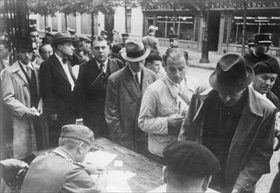 | 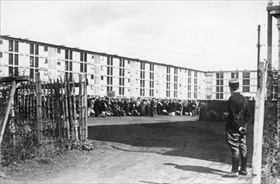 |
Left: Shortly after the German occupation of France in June 1940, the reactionary, collaborationist Vichy administration of Marshal Philippe Pétain, encouraged by occupation authorities, began a program of registering all 330,000 Jews in France; only half were French nationals. This photo shows officials examining the identity cards of Parisians stopped at a sidewalk table.
![]()
Right: The Drancy internment camp northeast of Paris was an interrogation, detention, and assembly camp, mainly for Jews, but also for communists, Freemasons, human smugglers (passeurs), and other “enemies” of the Vichy government. During the two-day “Vel’ d’Hiv” roundup on July 16–17, 1942, French police, working under the direction of German occupation authorities, brought 13,000 of their victims to the Velodrome d’Hiver, or Winter Velodrome, a Paris cycling stadium, before busing them to Drancy.
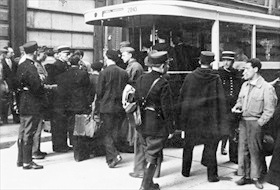 | 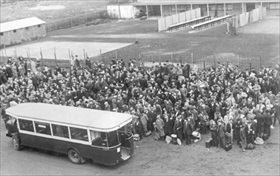 |
Left: French police arrest Jews in Paris and place them on a bus for transport to one of Vichy’s internment camps for registration and interrogation. The largest camp, Drancy, together with its five subcamps, first fell under French police administration. In 1943 the camps became the responsibility of the Gestapo Office of Jewish Affairs in France.
![]()
Right: Busloads of Jews arrive at Drancy internment camp in this August 1941 photograph.
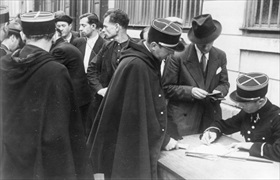 | 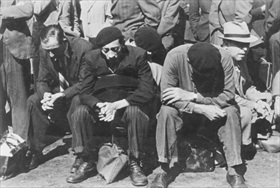 |
Left: French police process their Jewish hostages. The German Army set up internment camps to hold Allied civilians captured in areas it occupied in France. (France was split between a German-occupied zone in the north and west and a Vichy zone in the south.) Internees included U.S. nationals caught in Europe by surprise when Hitler declared war on America in December 1941, as well as British Commonwealth citizens caught in areas engulfed by the Blitzkrieg in the West.
![]()
Right: Traumatized Jews await an unknown fate. Between June 22, 1942, and the end of July 1944, 67,400 French, Polish, and German Jews were deported from France in 64 rail transports, mainly to Auschwitz but some to Sobibór, both extermination camps in Nazi-occupied Poland. Among them were 11,000 children, some less than two years old. At the Drancy camp just 1,542 internees remained alive when Allied forces liberated it on August 17, 1944.
Vichy French Newsreels from the Early 1940s. Includes Marshal Pétain Addressing Nation
![]()

 History buffs, there is good news! The Daily Chronicles of World War II is now available as an ebook for $4.99 on Amazon.com. Containing a year’s worth of dated entries from this website, the ebook brings the story of this tumultuous era to life in a compelling, authoritative, and succinct manner. Featuring inventive navigation aids, the ebook enables readers to instantly move forward or backward by month and date to different dated entries. Simple and elegant! Click
History buffs, there is good news! The Daily Chronicles of World War II is now available as an ebook for $4.99 on Amazon.com. Containing a year’s worth of dated entries from this website, the ebook brings the story of this tumultuous era to life in a compelling, authoritative, and succinct manner. Featuring inventive navigation aids, the ebook enables readers to instantly move forward or backward by month and date to different dated entries. Simple and elegant! Click 











